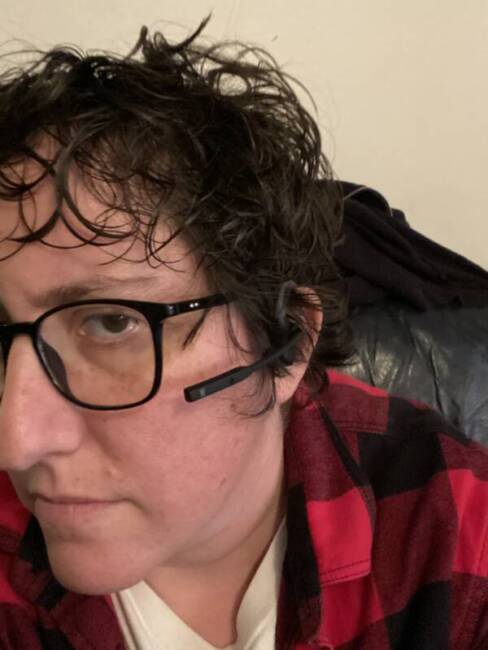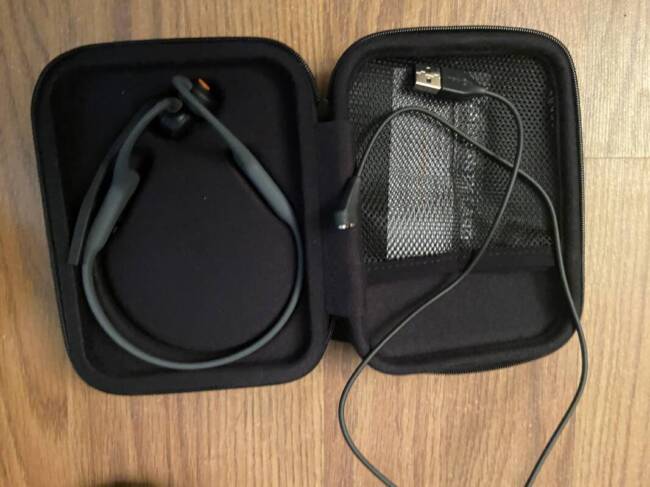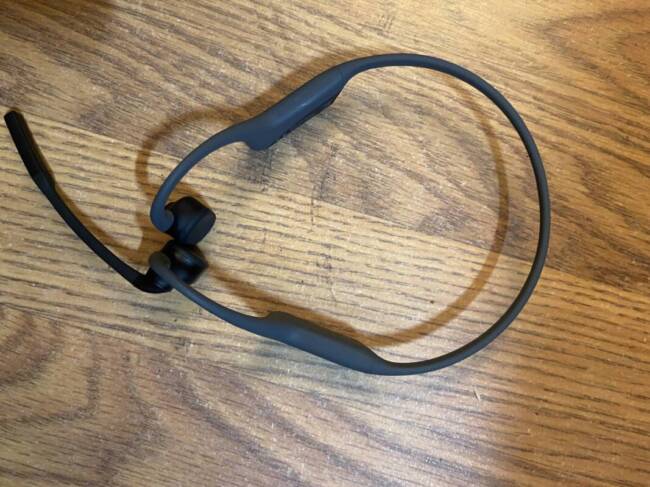The Lowdown
Overall, I liked the AfterShokz OpenComm immensely. They’re very comfortable, well-built, and if you get them adjusted properly, the feedback is that the sound quality is good. However, I do struggle with who the audience would be for these. I’m loving them right now because I’m working from home, but when I go back to the office, I have a wireless Plantronics headset connected to my desk phone-Bluetooth isn’t an option there.
Overall
Pros
- Good sound quality on the receiving end
- Long battery life
- Leaves you open to hearing your surroundings
- Build quality is excellent
- Carrying case is a nice touch
- Long battery life
Cons
- May need to be mindful of adjusting the boom mic
- Proprietary charging cable that’s a bit too short
- Expensive
I’m a huge advocate of AfterShokz, especially if you’re the type to listen to music while running, walking, hiking, etc. Having your ears open while still being able to enjoy music is a home run. AfterShokz thinks hearing your surroundings is important when you’re working too, and they’re applying their bone conduction headphones concept to a work-centric headset with the AfterShokz OpenComm. Does bone conduction spiff up well for the office? Read on to find out!

The basic look of the OpenComm is familiar if you’ve ever used AfterShokz regular headphones. They’re very light and fit nicely around the back of your head. There’s a multifunction button on the right ear side that answers and hangs up calls and can also start and stop the music. The volume buttons are beneath the right bone conduction speaker on the same side, so it’s easy to memorize and note where all your key buttons are located.

The left side has a small boom mic that swings out, which boasts adjustable DSP noise-canceling to help filter out background noise. You can also move the boom mic up or down, so it sits comfortably for you. AfterShokz says the OpenComm headset’s battery is good for 15 hours of talk time, and since we’ve been using them on and off for over a week and still haven’t had to charge them, it seems likely to meet or exceed that standard.
That’s your quick overview of the hardware, but if you’re not familiar with how bone conduction headphones work, here’s a brief explanation from the AfterShokz FAQ:
Unlike traditional headphones that use speakers to transmit sound, AfterShokz uses patented bone conduction technology. Transducers send mini vibrations through the cheekbones and deliver sound directly to the inner ear, bypassing the eardrum. This leaves your ears open to experience your surrounding environment.
As I said, I’ve used the AfterShokz OpenComm headset to play music, and while you’re not going to get audiophile quality, you do get an enjoyable music experience. I found the same type of experience when talking on the AfterShokz OpenComm, where the people on the other end came through nice and clear, but not necessarily as loudly when compared to over-the-ear headphones.

However, in a twist that pleasantly surprised me, I found that the bone conduction helped immensely with bringing the phone conversation front and center for my ears, even while my son was doing a Google Meet for school or watching YouTube far too loudly.
It’s not that the AfterShokz OpenComm drowned out the background noise, more that they created a situation where the call was clearly in the foreground of what I was hearing, so the background noise felt less distracting even though I was able to hear more of it. I could easily see someone being able to use these in an office context and not getting distracted.
There are a few high points as well as some concerns I have with the AfterShokz OpenComm. On the upside, as I said, my end’s sound quality has been excellent, and I haven’t had any issues with mishearing people. This is important in my line of work, where I need to hear strings of letters or numbers often clearly.
The AfterShokz OpenComm headset is also incredibly comfortable. I’m online and connected to my phone for work from around 8:30 am to 5 pm, and I literally don’t take my headset off during that time because I never know when I’ll get a call. With over-the-ear headphones, I eventually get sore ears or fatigue by midday, but I can wear the OpenComm all day and be quite comfortable.

The build quality is excellent as well. While they’re plastic, they feel tough and well-built with no seams or uneven spots. Everything about them indicates a well-designed product. If you sweat significantly while you work, or perhaps work in a rainforest, you’ll be happy to know they are IP55 waterproof, so you’re good if you get caught in the rain, although you can’t take calls while swimming laps.
AfterShokz also includes a fitted case for them, which is very nice if you haul your headphones around. There’s also a mesh pocket for the charger, which is a good segue into the things I’m less thrilled about with OpenComm…
Number one, the AfterShokz OpenComm uses a proprietary charger. I’m sure there’s a technical reason for this, maybe with space constraints, but it’s frustrating to have yet another charger to track. It’s especially frustrating if you’re tight on space or outlets because it means the OpenComm can’t “share” a charger with other devices.
For example, my son’s school Chromebook, his tablet, and several of my devices all use USB-C, so I can keep one or two USB-C cables plugged in and available for whichever device needs it. But now the OpenComm needs to take up one of my charger slots, and it’s the only one using that cable. It’s a minor annoyance, but it’s a friction point.
On the upside, the charger is magnetic, so it doesn’t take much fumbling or flipping around to get the AfterShokz OpenComm situated on the charger.
Ideally, if it had to use a magnetic proprietary charger, I’d rather AfterShokz offered a dock for the headset, where you could drop it on to charge and rest between calls. That, or make the cable longer, because a 2′ cable is too short to go from a surge protector to the desk, which means that the headphones either have to charge on the floor or I have to give up a USB slot on my computer dock to charge the OpenComm. It’s minor, yes, but these are $159.95, and at that price, it’s not unreasonable to expect a better charging experience.

The other issue with the AfterShokz OpenComm is a lot more subjective. I received feedback over the course of testing them that ranged from “You sound clearer than ever” to “Why are you calling me from a wind tunnel?” Unfortunately, I couldn’t quiz my business calls on whether I sounded ok, so I resorted to calling friends and family and randomly questioning the call quality.
My mother said it sounded like I was washing dishes while I talked to her, while my girlfriend said I sounded like I was in a windstorm. On the other hand, my father, my assistant, and our esteemed editor-in-chief, Judie, all indicated I sounded BETTER with the OpenComm.
It appears the issue was the placement of the boom mic-once I adjusted it, the feedback on how it sounded was much more positive. I’d strongly suggest doing a few test calls and dialing in the mic placement before taking any important calls on the AfterShokz OpenComm, just in case!
Overall, I liked the AfterShokz OpenComm immensely. They’re very comfortable, well-built, and if you get them adjusted properly, the feedback is that the sound quality is good. However, I do struggle with who the audience would be for these.
I love them right now because I’m working from home, but when I go back to the office, I have a wireless Plantronics headset connected to my desk phone-Bluetooth isn’t an option there.
If I worked from home full-time and someone gave me a budget to buy headphones, then the AfterShokz OpenComm would definitely be on the list. But for $159.95, it’s a hard sell when that puts you in the same range as headphones that can play music better while still adequately handling calls.
If the trend of work from home continues, I could see these being very useful, but since most corporate users are tied to approved headsets that tie into desk phones, it does seem like this fits a narrow niche.
I spend an insane amount of time on the phone, so these definitely appeal to me, but if you’re not constantly talking, the value proposition is a little tougher. However, if you’re on the phone enough that your family has learned your various “hold on/I’m on a call and can’t talk,” “turn the volume down on that show — why is it so loud?” hand gestures … you’re probably on the phone enough to need these!
The AfterShokz OpenComm headset sells for $159.95; it is available directly from the manufacturer and other retailers, including Amazon.
Source: Manufacturer supplied review sample
What I Like: Good sound quality on the receiving end; Long battery life; Leaves you open to hearing your surroundings; Build quality is excellent; Carrying case is a nice touch; Long battery life
What Needs Improvement: May need to be mindful of adjusting the boom mic; Proprietary charging cable that’s a bit too short; Expensive
